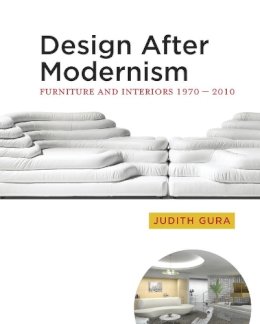
Stock image for illustration purposes only - book cover, edition or condition may vary.
Design After Modernism: Furniture and Interiors 1970-2010
Judith Gura
€ 70.59
FREE Delivery in Ireland
Description for Design After Modernism: Furniture and Interiors 1970-2010
Hardback. Bauhaus, Postmodernism, High Tech, and Green Design: Judith Gura explains the important movements, forms, and furnishings from the 1950s to the present. Num Pages: 208 pages, 400 full-color photographs. BIC Classification: AKR; AMR. Category: (P) Professional & Vocational. Dimension: 259 x 215 x 20. Weight in Grams: 992.
With the first decade of the twenty-first century behind us, it is time to reassess the concept of “modern,” a term that dates to the Middle Ages, when it signified current or recent events. Not until the eighteenth century did it become a stylistic term; more recently it has generally referred to the aesthetic that evolved from the Bauhaus and flourished in the mid-twentieth century. Though proclaiming freedom from the limitations of style, it became as formulaic as most of its predecessors, as Modern architecture and furnishings conformed to prescribed specifications: geometric forms, industrially fabricated, unadorned, and studiously ahistorical.
Those guidelines are no longer relevant. As Midcentury Modernism has receded into history, Modernism has been redefined, reenergized, and in the process transformed. Today it embraces a cornucopia of design in an almost limitless range of materials: design studios are laboratories for experimentation; design concepts can be as important as finished objects; and furniture has crossed barriers to become a new art form. Tools and technologies never before possible have provided new approaches to decoration, and may incorporate influences from the past. The design profession has broadened its horizons; interiors and furniture are being created by architects, interior designers, furniture makers, industrial designers, artisans, artists, and even fashion designers.
Design After Modernism offers an overview of developments in design over the past four decades—some evolutionary, some expected, and some extraordinary. It identifies the diverse influences that have generated new directions in design and illustrates many of the most characteristic, most noteworthy, and most innovative objects in this rich and variegated mix. All are representative of their time, and many of the earlier designs have already gained iconic status. Of the more recent ones, whether or not they will be admired in decades to come is something that only time will tell.
Those guidelines are no longer relevant. As Midcentury Modernism has receded into history, Modernism has been redefined, reenergized, and in the process transformed. Today it embraces a cornucopia of design in an almost limitless range of materials: design studios are laboratories for experimentation; design concepts can be as important as finished objects; and furniture has crossed barriers to become a new art form. Tools and technologies never before possible have provided new approaches to decoration, and may incorporate influences from the past. The design profession has broadened its horizons; interiors and furniture are being created by architects, interior designers, furniture makers, industrial designers, artisans, artists, and even fashion designers.
Design After Modernism offers an overview of developments in design over the past four decades—some evolutionary, some expected, and some extraordinary. It identifies the diverse influences that have generated new directions in design and illustrates many of the most characteristic, most noteworthy, and most innovative objects in this rich and variegated mix. All are representative of their time, and many of the earlier designs have already gained iconic status. Of the more recent ones, whether or not they will be admired in decades to come is something that only time will tell.
Product Details
Format
Hardback
Publication date
2012
Publisher
WW Norton & Co United States
Number of pages
224
Condition
New
Number of Pages
208
Place of Publication
New York, United States
ISBN
9780393733044
SKU
V9780393733044
Shipping Time
Usually ships in 7 to 11 working days
Ref
99-1
About Judith Gura
Judith Gura is a professor at the New York School of Interior Design, where she directs the design history program and is coordinator of public programs. A graduate of Cornell University, she has a master’s degree in the history of the decorative arts from the Bard Graduate Center. She has worked on exhibitions at the Brooklyn Museum, the Whitney Museum, and the National Museum of Women in the Arts. Her published works include New York Interior Design, 1935-1985, Sourcebook of Scandinavian Furniture, Guide to Period Styles for Interiors, Harvey Probber: Modernist Furniture, Artworks and Design, and Edward Wormley: The Other Face of Modernism. She is a contributing editor for Art+Auction, and lectures frequently on interior design and furniture styles.
Reviews for Design After Modernism: Furniture and Interiors 1970-2010
" Discover all that is exciting about contemporary styling in this fabulous book. . . "
Essential Kitchens, Bathrooms, Bedrooms Magazine "[P]rovides surprising breadth and depth in a compact volume. . . . [M]akes the greatest scholarly contribution with a wide range of environmentally responsible approaches to design. Recommended."
CHOICE "[A] treat to the eye and intellect."
modernism magazine "A useful and invaluable resource . . . . A wonderful scholarly work . . . . [T]he visuals and the text supplement each other beautifully, offering various readers different entry points and degrees of accessibility."
ARLIS/NA Reviews
Essential Kitchens, Bathrooms, Bedrooms Magazine "[P]rovides surprising breadth and depth in a compact volume. . . . [M]akes the greatest scholarly contribution with a wide range of environmentally responsible approaches to design. Recommended."
CHOICE "[A] treat to the eye and intellect."
modernism magazine "A useful and invaluable resource . . . . A wonderful scholarly work . . . . [T]he visuals and the text supplement each other beautifully, offering various readers different entry points and degrees of accessibility."
ARLIS/NA Reviews
